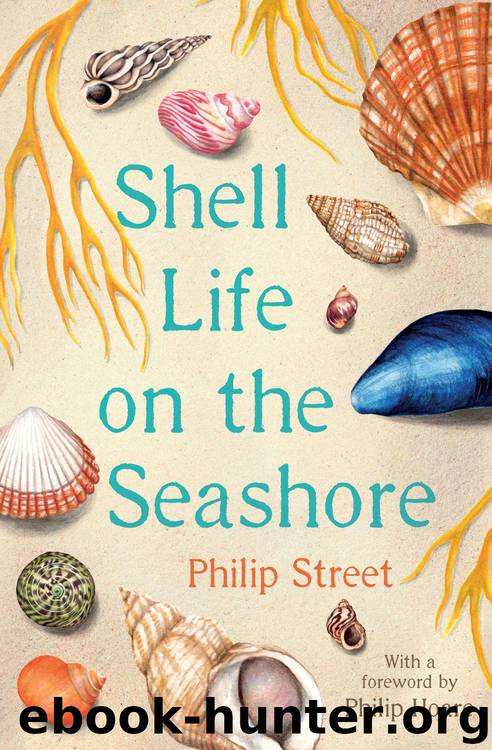Shell Life on the Seashore by Philip Street

Author:Philip Street [Philip Street]
Language: eng
Format: epub
ISBN: 9780571359110
Publisher: Faber & Faber
Published: 2019-03-18T16:00:00+00:00
Slightly smaller than the queen scallop, the variegated scallop (Mimachlamys varia) is distinguished by having unequal ears, while the fourth species, the humpback scallop (Talochlamys pusio), is not likely to be confused with any of the other three species. Its shell is irregular in shape, except when it is very young, and it does not swim about, but attaches itself by means of byssus threads to rocks or stones. Despite its sedentary habits, it does possess eyes like the other species, which suggests that it is descended from a free-swimming ancestor.
In its perfection of design and proportion the scallop shell is perhaps more beautiful than the shell of any other bivalve mollusc, and it is not surprising that it has been much used by artists from early times. In medieval times the scallop shell was adopted as the badge worn by pilgrims to show that they had visited Jerusalem.
Related to the scallops are the file shells, so called because the ribs on their white shells are so numerous and close together that the whole surface resembles a file. Like the scallops, they are capable of moving through the water, but are normally sedentary. The edges of the mantles are well supplied with tentacles, as are those of the scallop, but they are very much longer and project as a double fringe well beyond the shell valves, so that these have to remain permanently open. Movement through the water is brought about by a slow waving of these fringes of tentacles.
Since these tentacles cannot be withdrawn, and the valves have consequently to be kept open, the file shell is very much at the mercy of predators. To overcome this disadvantage it has learned to make a nest, a thing which no other bivalve is able to do. The whole shell is surrounded with a copious production of byssus threads to which sand grains, small stones, pieces of shell and seaweed, and other particles adhere. Openings are left through which inhalant and exhalant water currents can pass. Eyes are present on the mantle but are less well developed than those of the scallops.
In early life file shells swim about freely in the water like scallops, settling down to nest building and a sedentary life as they become adult. The largest and best-known British species is the gaping file shell, also known as the flame shell (Limaria hians), a very beautiful creature when seen alive, with its orange mantle and hundreds of orange filaments waving about in the water like the tentacles of a sea-anemone. In 2012, divers found a huge reef of gaping file shells in waters off the Isle of Skye in Scotland. Covering an area of sea bed of roughly seventy-five hectares (or about the same as three thousand tennis courts), it was made up of an estimated 100 million file shells.
Download
This site does not store any files on its server. We only index and link to content provided by other sites. Please contact the content providers to delete copyright contents if any and email us, we'll remove relevant links or contents immediately.
The Lonely City by Olivia Laing(4120)
Animal Frequency by Melissa Alvarez(3755)
All Creatures Great and Small by James Herriot(3517)
Walking by Henry David Thoreau(3234)
Exit West by Mohsin Hamid(3184)
Origin Story: A Big History of Everything by David Christian(3139)
COSMOS by Carl Sagan(2950)
How to Read Water: Clues and Patterns from Puddles to the Sea (Natural Navigation) by Tristan Gooley(2855)
Hedgerow by John Wright(2777)
The Inner Life of Animals by Peter Wohlleben(2767)
Origin Story by David Christian(2684)
How to Read Nature by Tristan Gooley(2665)
Project Animal Farm: An Accidental Journey into the Secret World of Farming and the Truth About Our Food by Sonia Faruqi(2661)
How to Do Nothing by Jenny Odell(2645)
A Forest Journey by John Perlin(2588)
Water by Ian Miller(2584)
The Plant Messiah by Carlos Magdalena(2454)
A Wilder Time by William E. Glassley(2364)
Forests: A Very Short Introduction by Jaboury Ghazoul(2335)
